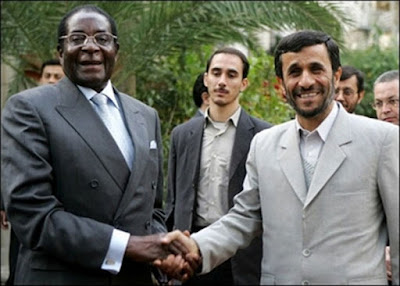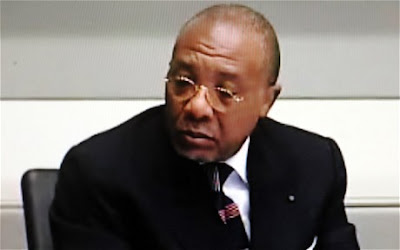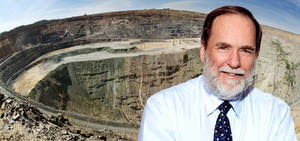
On this big night out, Gisele Bündchen, darling of the cameras, is decked out in diamond earrings from Van Cleef & Arpels. The cover girl Shalom Harlow wears rocks from Harry Winston. And Madonna, that proto-Gaga, is bejeweled in Cartier.
But none of the gems actually belongs to them.
At the May gala of the Metropolitan Museum of Art Costume Institute, these A-listers are simply borrowing their baubles from some big names in diamonds, a common P.R. tactic in the high-glitz business of gems.
Yet jewels from Laurence Graff, perhaps the biggest dealer in seriously big stones, are rare this evening.

The King of Really Big Diamonds
“The people who wear Graff jewelry own it,” says Henri Barguirdjian, who heads Mr. Graff’s United States sales operation. “I think it is a bit of an insult to our clients who actually purchased our jewelry,” he adds, referring to the notion of non-owners wearing Graff jewels. “If you spend $1 million, that is a lot of money. Do you want a little model wearing it?”
It might seem remarkable that anyone would spurn a little free fashion buzz, particularly in a business like diamonds, and particularly in tough economic times. Lending jewels to boldface names is standard practice.
Standard, perhaps — but not at Graff Diamonds. The retail business, however, is only part of an empire that extends from luxe showrooms in London to gritty diamond mines in southern Africa to cutting rooms in Antwerp, Belgium, and beyond. It is a world that at times seems impervious to the fortunes of mere mortals, though not, it turns out, to the shifting sands of the global economy.
Beneath the headquarters of Graff on Albemarle Street, in the Mayfair section of London, is a warren of workrooms. There, 170 people produce the jewelry that Graff sells worldwide.
But now Mr. Graff is pushing into China, where the number of billionaires is climbing annually — and ranks second only to that of the United States. Everyone else is piling in, too. The exploding market for diamonds in China, it seems, is yet another sign of its rising economic might, or at least the willingness of its ultrarich to spend — and spend big.
“We make more sales to newer money than to older money,” Mr. Graff says in explaining China’s appeal. “Americans are not attracted in the same way in spending money on jewelry as in the Far East.”
Let others fret over a mere carat or two. Mr. Graff’s purchases of giant gems awe the diamond world. Over the decades, he has sold many major stones, including the Magnificence, a 244-carat white diamond, and the Maharajah, a 78-carat yellow diamond. Graff Diamonds hit the headlines in 2009 when robbers made off with $65 million of gems from its shop in Mayfair, in the largest jewel heist in British history. (The jewels have not been recovered.)
His customers have included Oprah Winfrey, Arnold Schwarzenegger, Denzel Washington, Victoria Beckham and Danielle Steel. In the past three years, Mr. Graff spent more than $100 million on four diamonds. That’s right: $100 million to buy just four stones. For one of them, a flawless, 24.78-carat pink diamond, he paid a record $46 million last year at a Geneva auction.
And he is not likely to lend it to anyone for the evening.
Today, Mr. Graff’s offerings include a necklace of 26 stones cut from the Lesotho Promise, a 603-carat rough stone that he bought for $12.4 million from the Letseng Mine in the African country of Lesotho. The company now values the necklace at more than $60 million. Also for sale is the Graff Constellation, a 102.79-carat flawless round diamond that was cut from the $18.4 million, 478-carat Light of Letseng.
Not that he buys only rough stones. He paid $24 million for the 35.5-carat Wittelsbach diamond, a fancy blue stone that is a rival to the Hope Diamond. In a controversial move, he recut the diamond to remove imperfections, prompting criticism that he had essentially painted over a Rembrandt. The Wittelsbach Graff sold recently for an undisclosed amount.
Mr. Graff oversees a network of 32 stores worldwide, and owns 12.14 percent of Gem Diamonds, a publicly traded mining company. Through a 51 percent stake, he controls the South African Diamond Corporation, which cuts and polishes diamonds; Safdico has 520 employees in places like Johannesburg, Antwerp, Mauritius and Botswana.
Though Hollywood celebrities are often photographed wearing big gems, “they are not big purchasers,” Mr. Graff, 73, says. “They don’t have that sort of money.”
Increasingly, the sort of money that moves this market is Chinese. Though buyers rarely disclose purchases, experts agree that the Chinese appetite for diamonds — particularly for colored diamonds — is growing.
The American diamond market, like the American economy, has slowed in recent years. Mr. Graff plans only one new store in United States, in San Francisco, a city that has many visitors from Asia. Graff already has three stores in East Asia, and plans to open one in mainland China and one on Taiwan.
The swing to Asia, and China in particular, has startled even Graff’s veteran management. “If you had told me five years ago that the biggest buyers would come from the People’s Republic of China, we would have laughed,” says Mr. Barguirdjian, Mr. Graff’s longtime lieutenant. “It took us by surprise. America used to be the No. 1 market. Now that is being challenged.”
Graff, of course, is hardly the only player in China. Competition there, even for Graff, is fierce. DeBeers has two stores in China and is opening three more this year. Tiffany & Company has 15 stores in China among its total of 240, and is planning more. Leviev, another major diamond dealer, has no stores in China, though it just finished a two-week exhibit in Shanghai and Beijing.
DIAMONDS are in many ways a hush-hush business. The inner workings of Graff, like those of most of the big players, are difficult to penetrate. While Compagnie Financière Richemont, owner of Cartier and Van Cleef, is traded on the Swiss stock exchange, it does not break out those jewelers’ earnings. Nor does DeBeers Diamond Jewelry, the retail operation DeBeers owns with the luxury giant LVMH Moët Hennessy Louis Vuitton, disclose the profits from its retail stores.
At Graff, one must depend on Mr. Graff’s numbers.
Sitting in his elegant shop on the Upper East Side of Manhattan, Mr. Graff, dressed in a tailored blue suit and blue tie, says 2010 was a good year for his empire. His companies, he says, generated worldwide sales of nearly $1 billion. Of that, $437 million came from Graff Diamonds, the retail arm, which turned a profit of $64 million after taxes.
The balance of his operations include his stake in Safdico, the diamond and polishing business, as well as Diamond Works, a wholesale diamond company. Those two are in turn under the umbrella of AE Holdings. All are based in countries known as tax havens — AE in Switzerland, Safdico in Mauritius and Diamond Works in Luxembourg. Revenue from those businesses last year totaled $550 million, Mr. Graff says, but margins are far lower than in the retail business. (He declines to elaborate.)
All of this has been highly lucrative for him. The Sunday Times of London has estimated his wealth at $3.2 billion in 2010. His holdings also include a vineyard and a resort in South Africa, as well as an art collection that includes Picassos and Warhols. He gave up his British residency 11 years ago, moving to Geneva and Gstaad, Switzerland, where the personal income tax rate is far lower than in Britain.
Like Harry Winston, who died more than three decades ago, Mr. Graff has made his fortune selling big diamonds. But his beginnings were humble. The son of Jewish immigrants from Eastern Europe, he grew up in the hard-scrabble East End of London. “From an early age, I could see a little area called Black Lion Yard where the Jewish people bought diamonds,” he recalls. It was, he says, a place where people wanted to put their money in something that seemed safe, something tangible.
“It has been the same forever,” he says. “Whether it was royal families in different parts of the world, or today, when people worry that their dollars are worth nothing, they want assets that will increase in value — silent assets that you can put in your pocket because tomorrow, anything can go wrong.”
As a young man, Mr. Graff was such a poor student that by the time he was 14, his mother had arranged for him to work as an apprentice for a jeweler, doing chores like washing floors and fetching sandwiches. He lost that job. “I guess I was not good enough,” he recalled.
Shortly thereafter, he went into a jewelry business with a partner. That venture went into debt, and Mr. Graff decided to take it over. Within six months he had paid off the debt and, displaying a certain panache for sales, began traveling around Britain, selling jewelry made with semi-precious stones. Mr. Graff later helped make some of the costume jewelry that Elizabeth Taylor wore in her film role as Cleopatra, alongside Richard Burton.
Soon Mr. Graff was traveling to Asia. His first coup was on a trip to Singapore, where a local department store bought his collection. By the 1970s, he was off to Japan, Hong Kong and the Middle East. “I went everywhere,” he says. “I was the first real Westerner who came into that market as a wholesaler: a man carrying a case of jewels.”
Starting in the 1970s, Mr. Graff began selling jewels to the sultan of Brunei. Mr. Graff became close enough to the royal family that the sultan’s brother lent him his Aston Martin during his visits. On a trip to the Philippines, he sold millions of dollars in jewelry to Imelda Marcos.
By the time wealthy Arabs arrived in London in the 1980s, Mr. Graff was the man to see. At that time, prices for big stones were beginning to rise. A watershed moment came in 1987: François Curiel, who heads the jewelry department for Christie’s, president of Christie’s Asia, recalled that in that year, a red diamond weighing 0.95 carat sold for $880,000, or $926,000 a carat. Before that, the highest price per carat for a diamond was $127,000. That was an anomaly, but prices for large colored stones have since been rising.
WHEN the petrodollars stopped gushing, Mr. Graff looked beyond the Middle East. In 1998, he bought his 51 percent of Safdico. Three years later, he opened his first store in the United States. To establish his brand here, he struck a deal to open a number of boutiques in Saks Fifth Avenue stores. “That got our name out overnight,” he says.
Despite all the publicity about major diamond sales, even experienced dealers still struggle to read the tea leaves.
At a Christie’s jewelry auction in April this year, the Graff team decided to bid up to $2.6 million for a fancy blue 3.25-carat diamond that was estimated to sell for $3 million to $3.2 million. (On top of the auction price, buyers must pay Christie’s an additional 20 percent.)
Graff’s thinking was that a retailer could not possibly charge a big-enough mark-up over $3 million to spend more for the stone. When a buyer agreed to a total of $3.66 million, Mr. Barguirdjian concluded that the buyer was probably a private individual in Asia, because “three carats is too small for an American.” He was half-right: it was an individual, but from Europe.
Just how Graff manages to carry an inventory worth many hundreds of millions is one of the great puzzles of the diamond market. Even experts scratch their heads about its finances.
One veteran jeweler, who did not want to comment publicly on industry names, says of Mr. Graff: It is “a mystery where he gets the financing to carry so much inventory.” But Mr. Graff says that carrying the inventory is no problem.
While the world of Graff might seem unaffected by the ups and downs of the workaday economy, it was in fact hurt by the recent slowdown. In 2008 and 2009, even the superrich pulled back.
In 2008, Graff Diamonds turned a pretax profit of $77 million on sales of $538 million, according to its chief financial officer, Nick Paine. In 2009, sales dropped to $432 million, and pretax profits to $62 million. Last year, sales were virtually flat, but pretax profits jumped to $86 million, mostly because of sales of smaller pieces with higher mark-ups. Which raises the question of how large his inventory of large stones has become.
Mr. Graff says he can turn a bigger profit by buying large, rough stones. “I will make my money on buying the rough, in my polishing it and getting it to a certain level of market price,” he says.
It can take from three months to a year to cut a rough stone. Cutting the Lesotho stone into 26 pieces, for instance, took nearly a year and involved more than a dozen people, he says.
Over time, the appetite for big stones hasn’t surprised Martin Rapaport, publisher of the Rapaport Diamond Report, an industry bible. Big diamonds are a way to move money without a trace. “Billionaires everywhere in the world like to keep some of their wealth in something easily transportable,” he says.
Mr. Graff, now in his eighth decade, is circumspect about the future. His son François, 47, works for him in London. But two years ago, a potentially smooth family transition seemed at risk. Mr. Graff and his wife of 47 years, Anne Marie, were set to divorce after Mr. Graff fathered a child with a woman who had worked for him. The London tabloids screamed that it would be the largest divorce settlement in British history.
At the last minute, the couple reconciled. And Mr. Graff is open in recognizing his daughter. “She carries my name and her mother’s name,” he said last week.
The Graff family empire, flawless or not, seems to be diamond-hard.
This story originally appeared in The New York Times






























